 |
||||||
|
HOME
|
US Navy -
ships
|
US Navy - air
units
|
USMC - air
units
|
International
Navies
|
Weapon Systems
|
Special Reports |
||||||
|
US Marine Corps - Marine Fighter Attack Squadron
214 VMFA-214 'Black Sheep' |
||||||
|
||||||
| 09/24 | ||||||
|
||||||
| images | ||||||
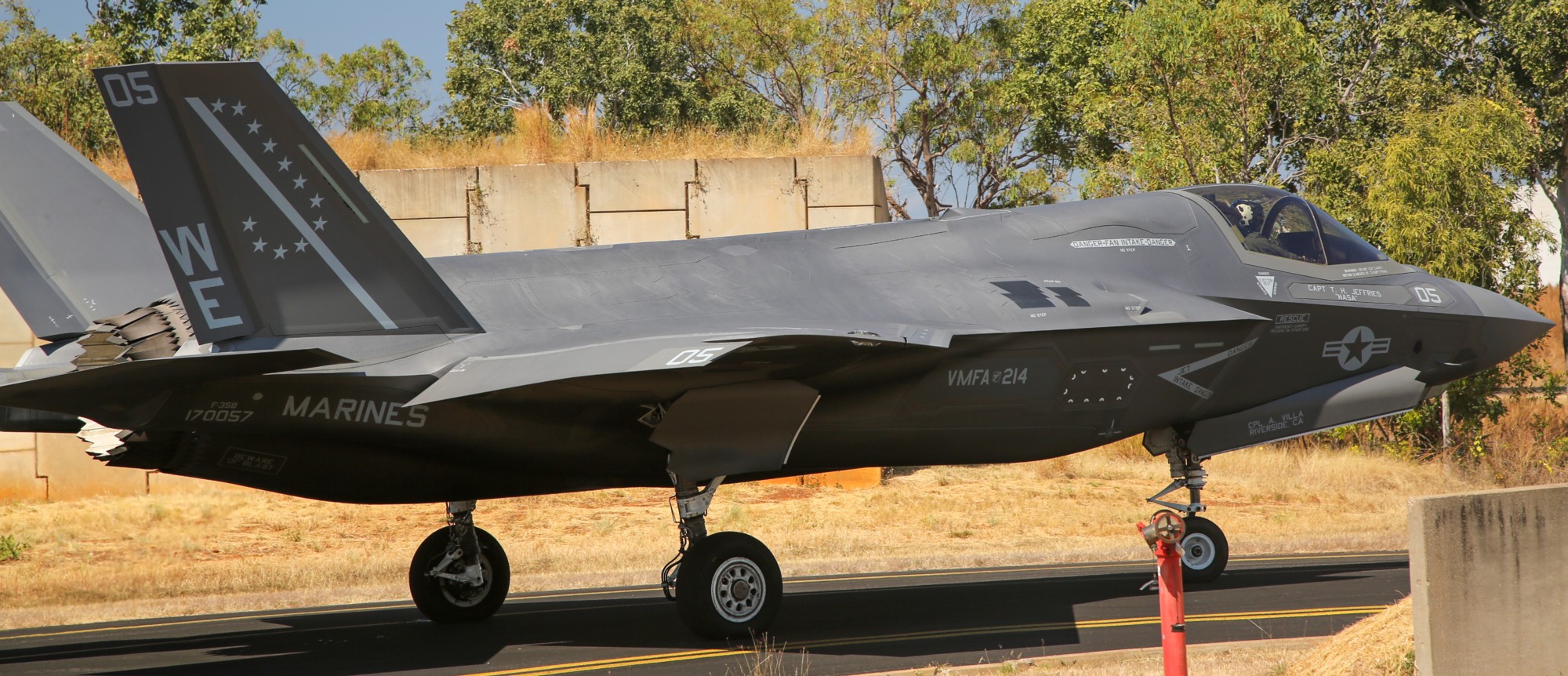 F-35B Lightning II (VMFA-214) at RAAF Tindal, Australia - June 2024 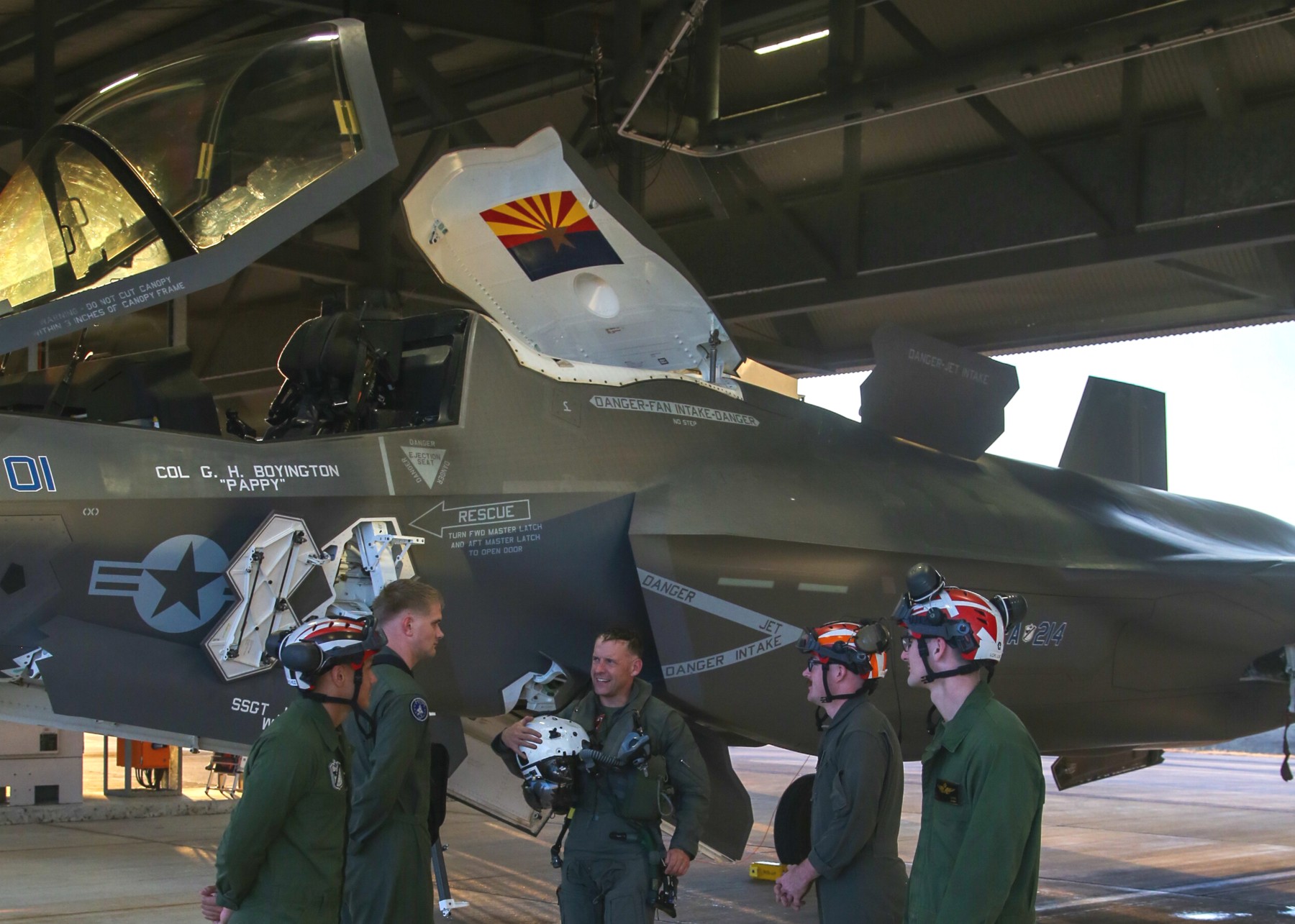 F-35B Lightning II (VMFA-214) at RAAF Tindal, Australia - June 2024 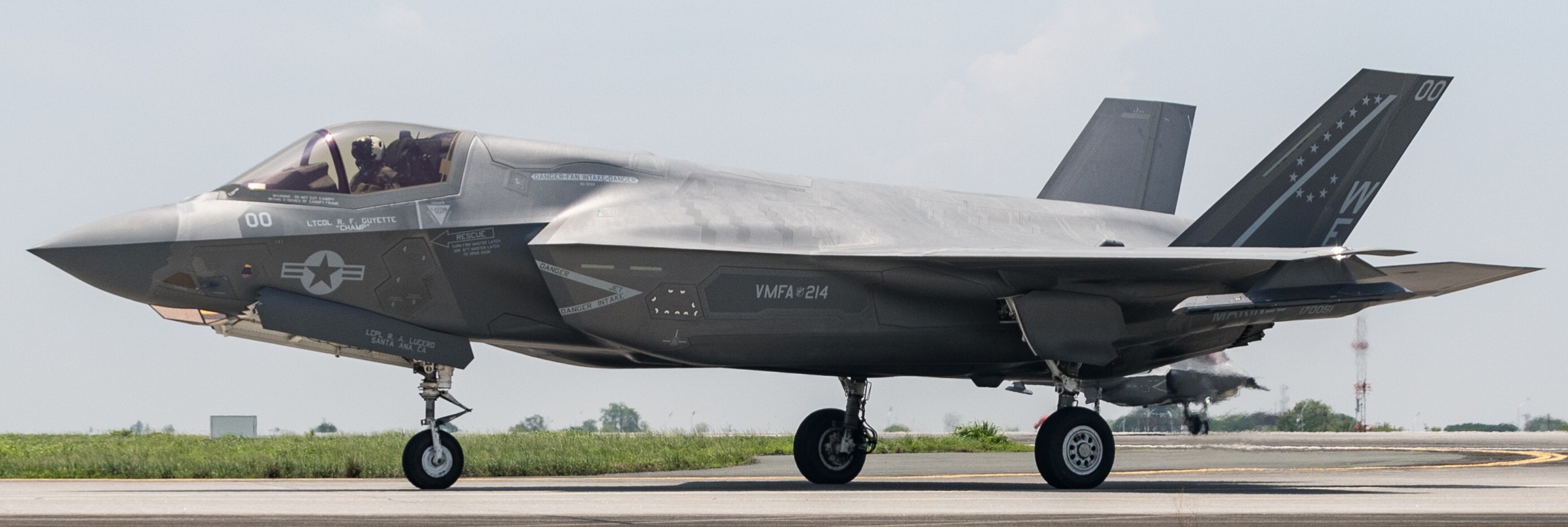 F-35B Lightning II (VMFA-214) at Clark Air Base, Philippines - June 2024 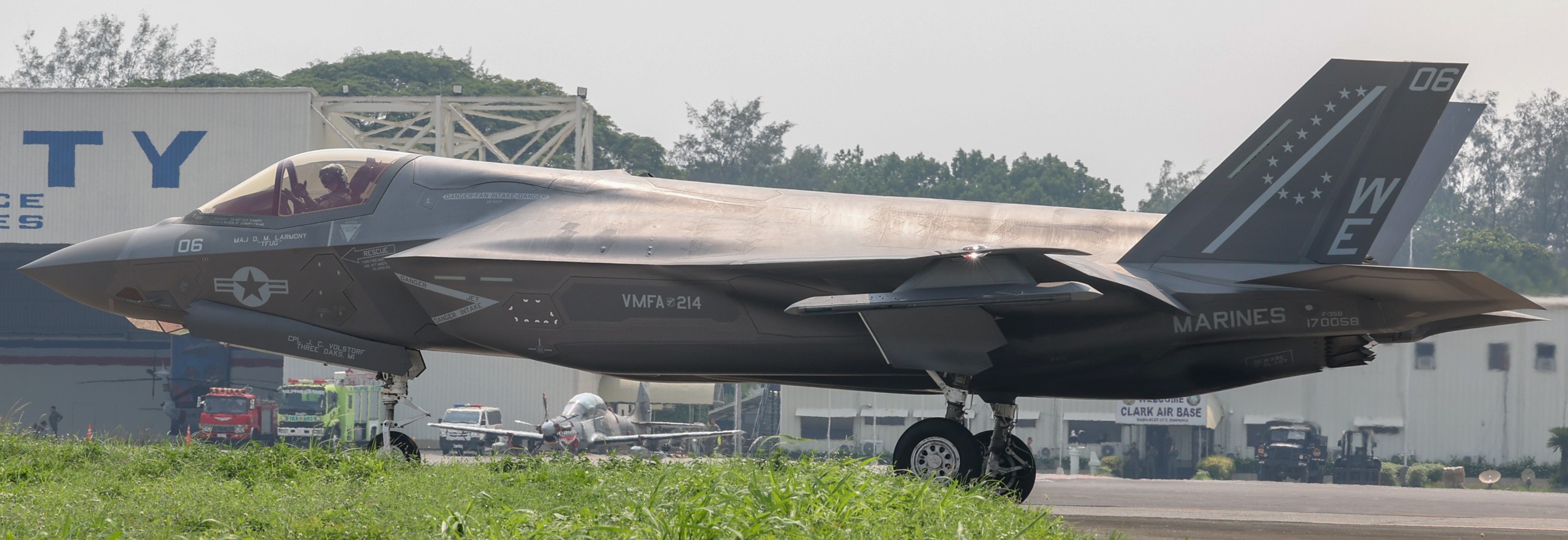 F-35B Lightning II (VMFA-214) at Clark Air Base, Philippines - June 2024 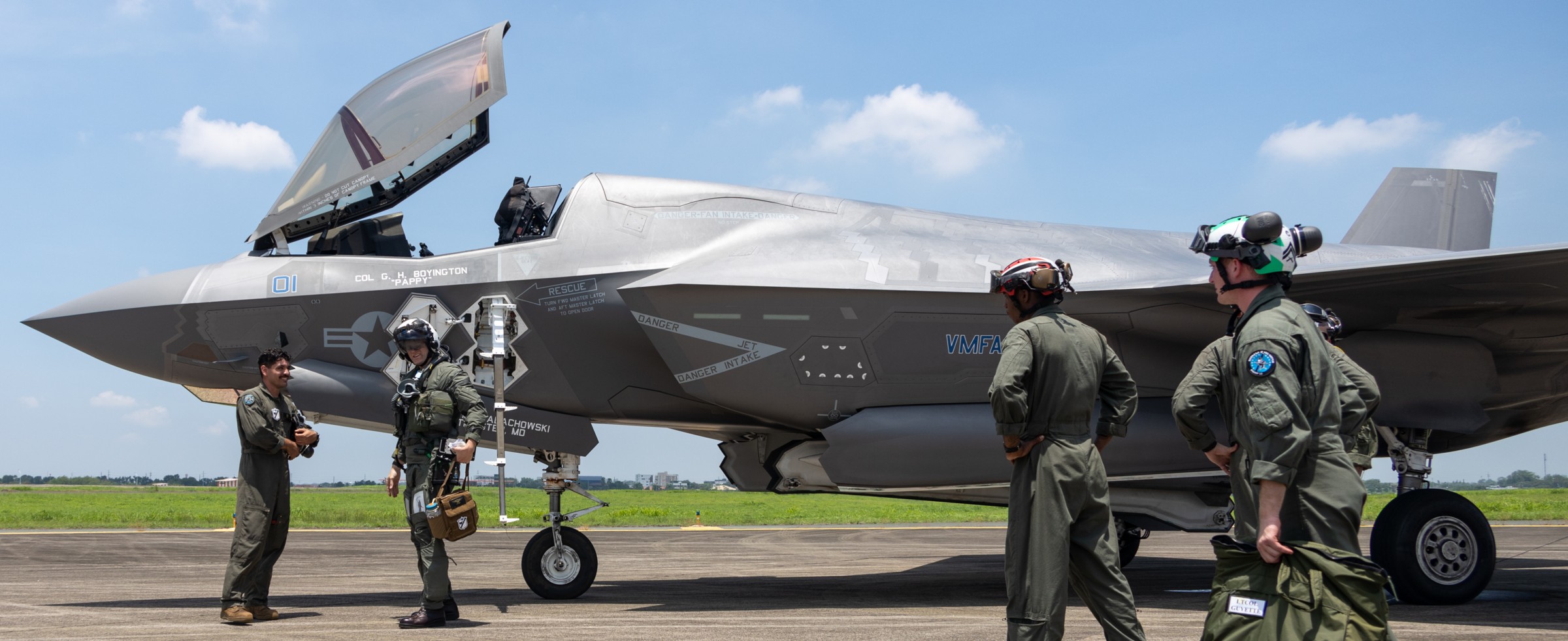 F-35B Lightning II (VMFA-214) at Clark Air Base, Philippines - June 2024  F-35B Lightning II (VMFA-214) at Clark Air Base, Philippines - June 2024  F-35B Lightning II (VMFA-214) at Clark Air Base, Philippines - June 2024 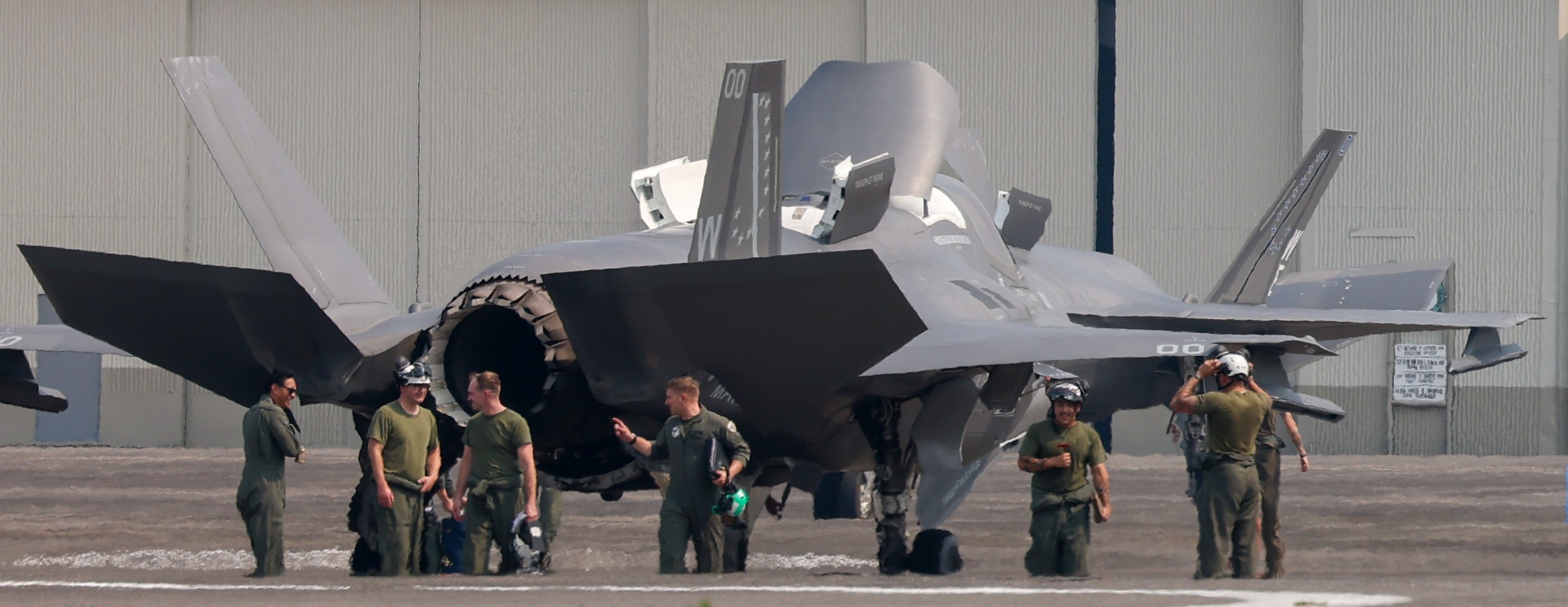 F-35B Lightning II (VMFA-214) at Clark Air Base, Philippines - June 2024 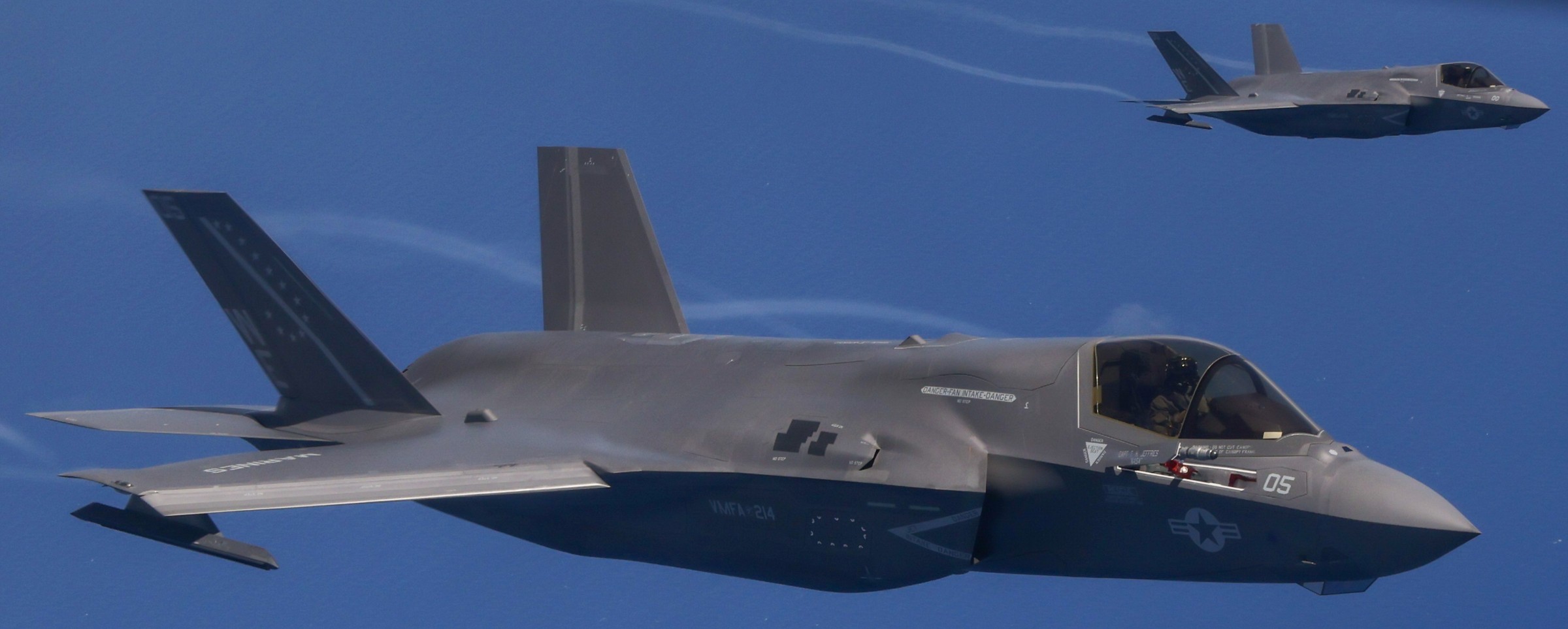 F-35B Lightning II (VMFA-214) over the Pacific Ocean - June 2024 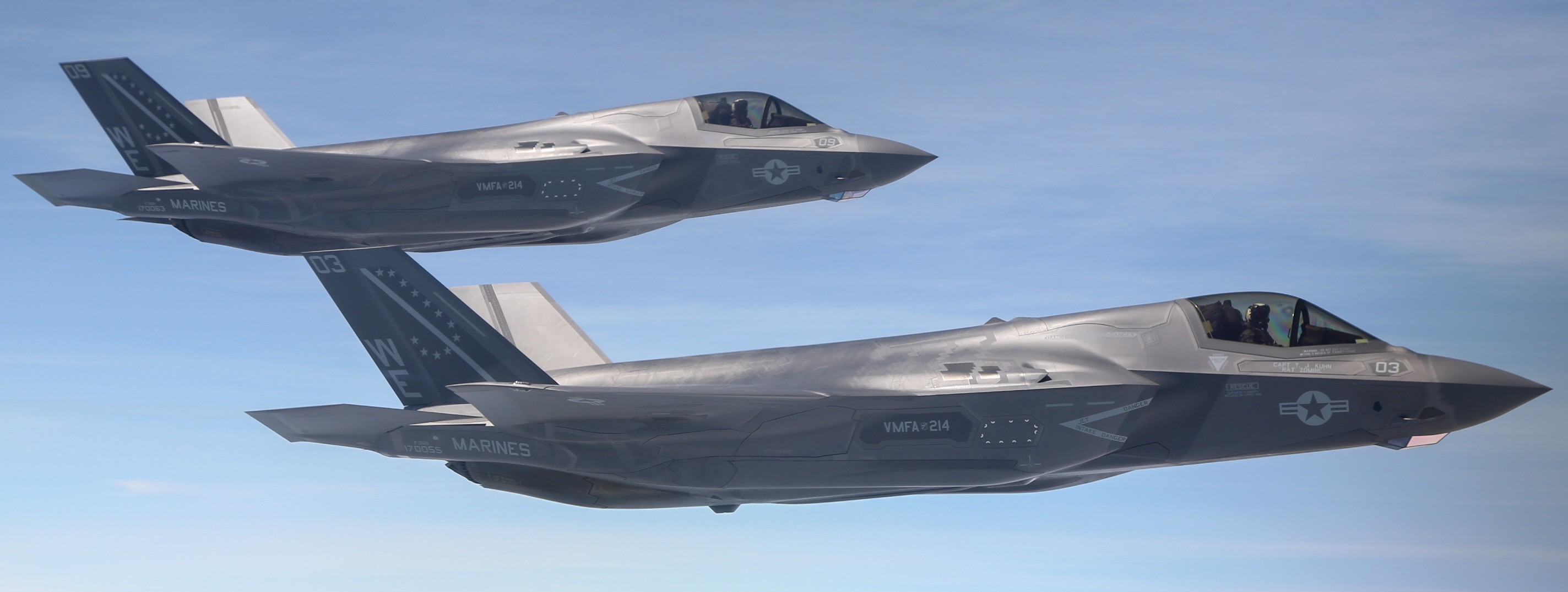 F-35B Lightning II (VMFA-214) - Pacific Ocean - May 2024 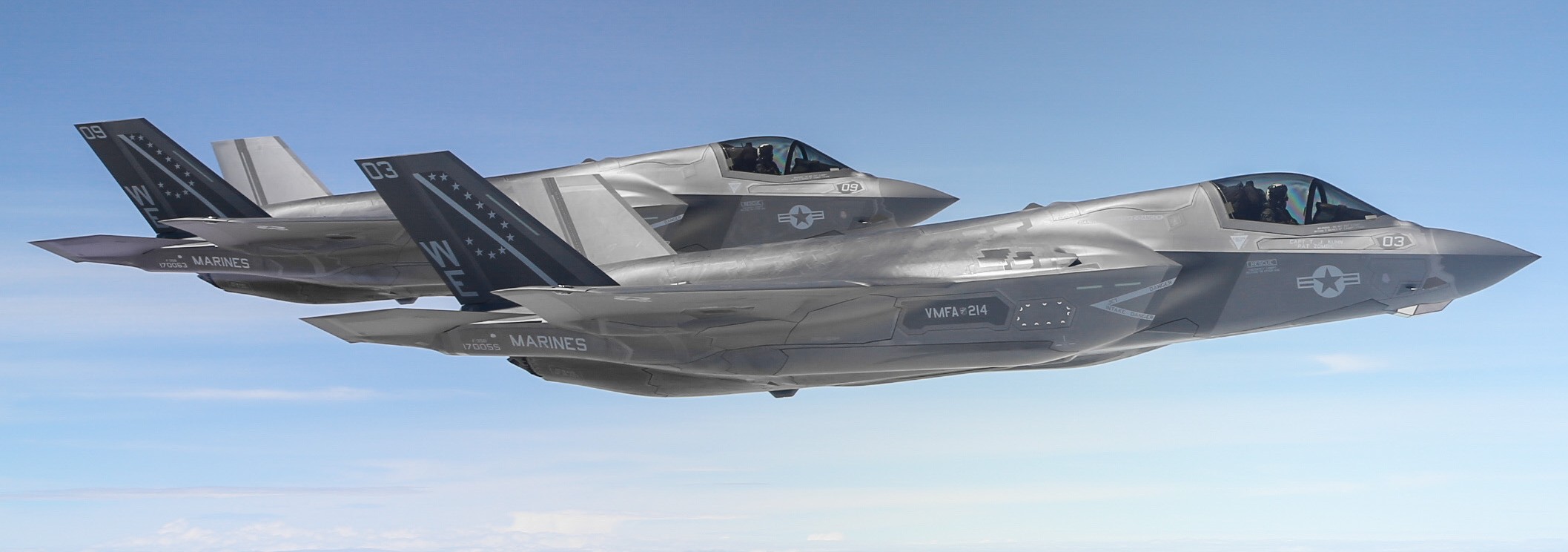 F-35B Lightning II (VMFA-214) - Pacific Ocean - May 2024 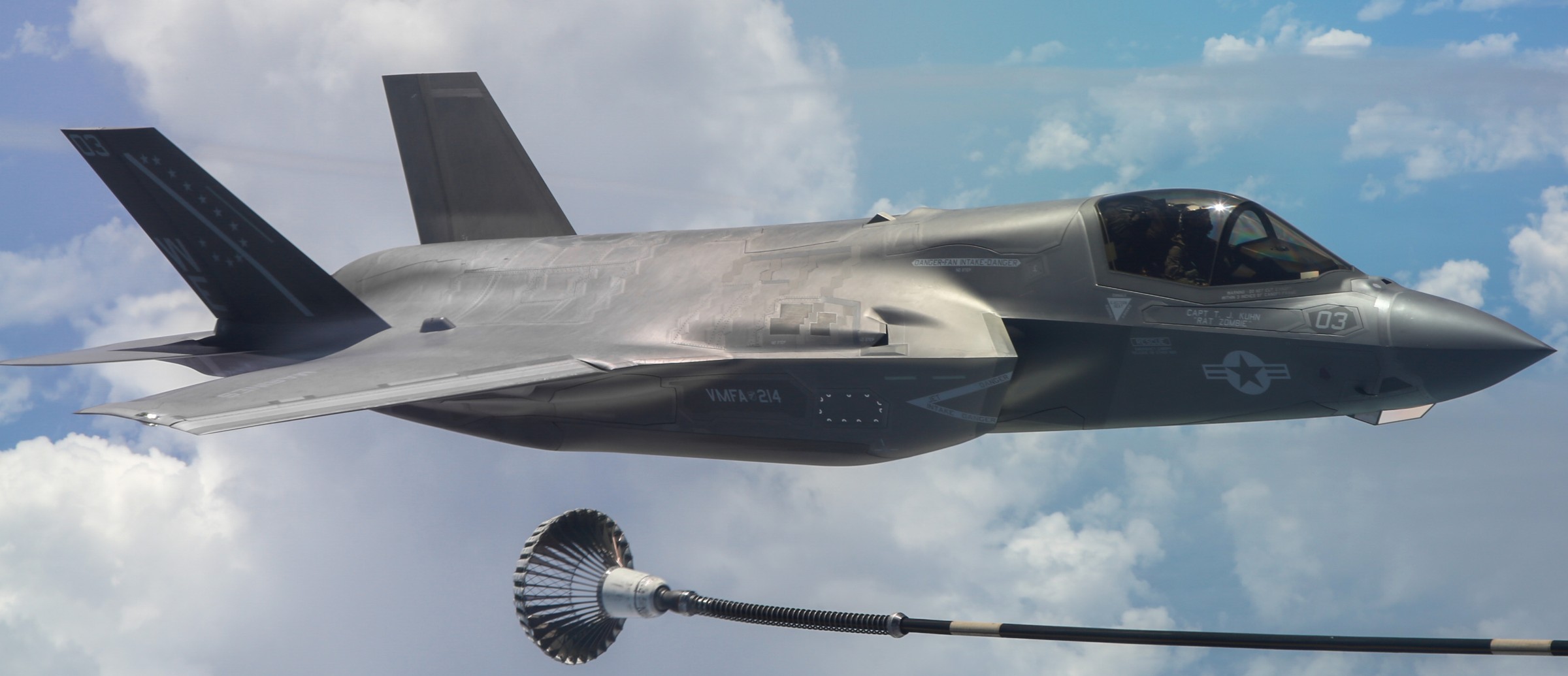 F-35B Lightning II (VMFA-214) - Pacific Ocean - May 2024  F-35B Lightning II (VMFA-214) - Pacific Ocean - May 2024 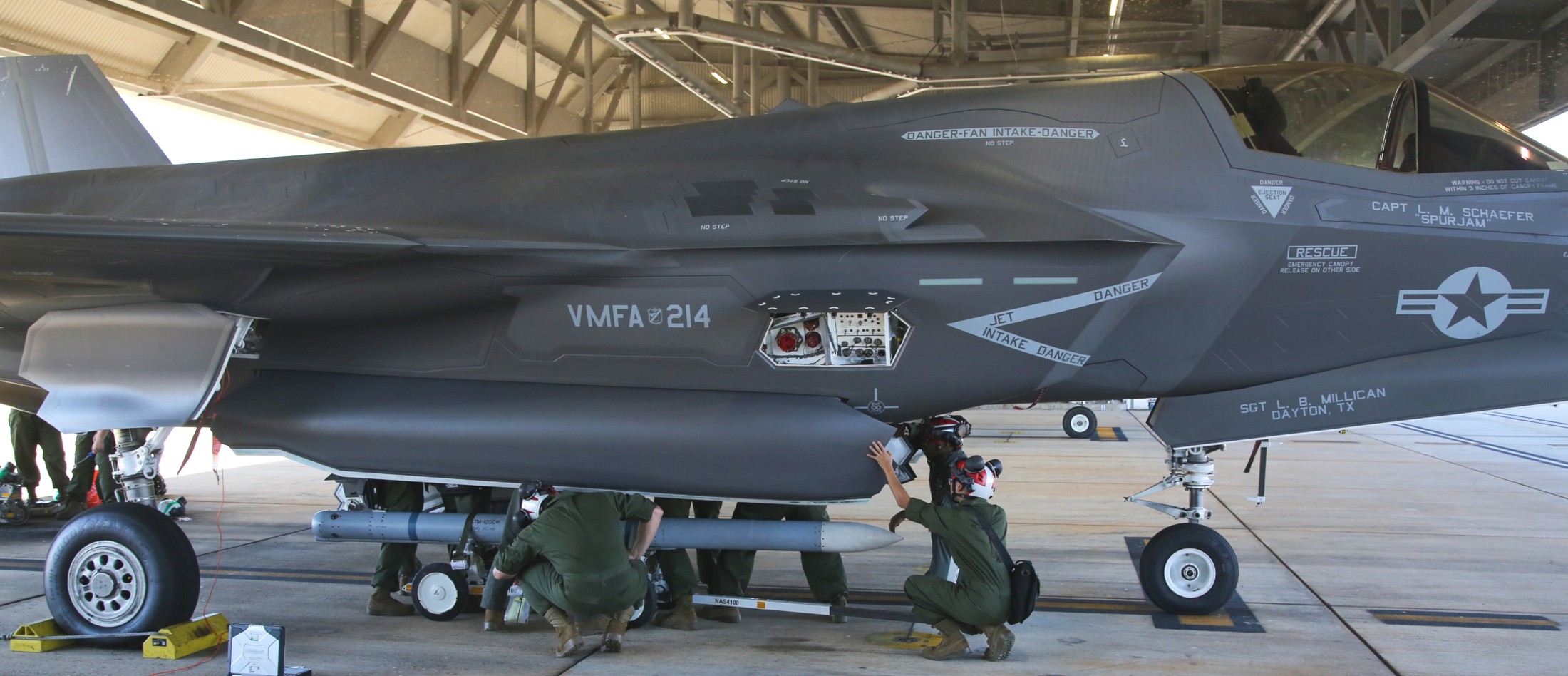 F-35B Lightning II (VMFA-214) - CATM-120C missile load exercise at RAAF Tindal, Australia - May 2024 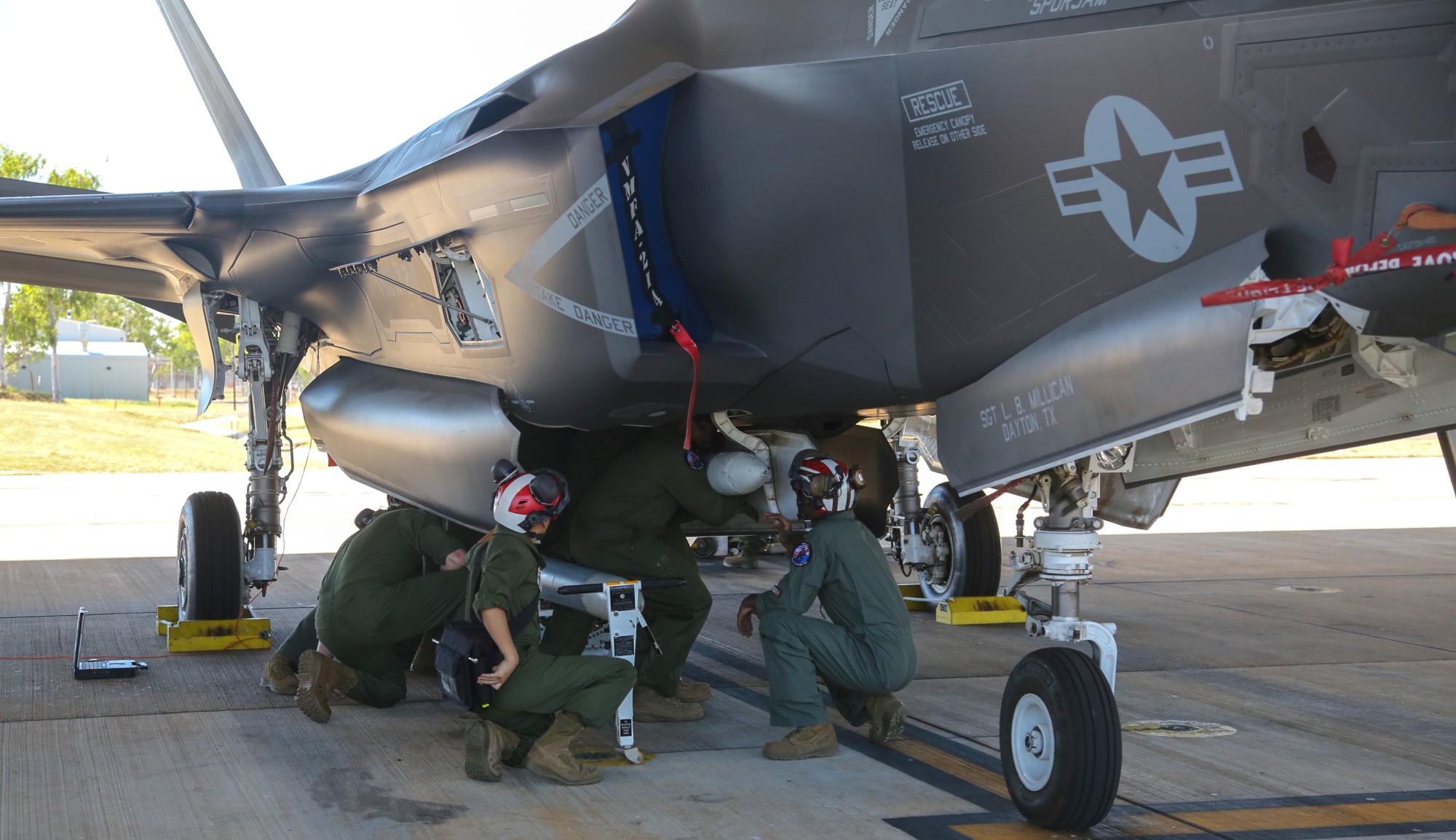 F-35B Lightning II (VMFA-214) - CATM-120C missile load exercise at RAAF Tindal, Australia - May 2024 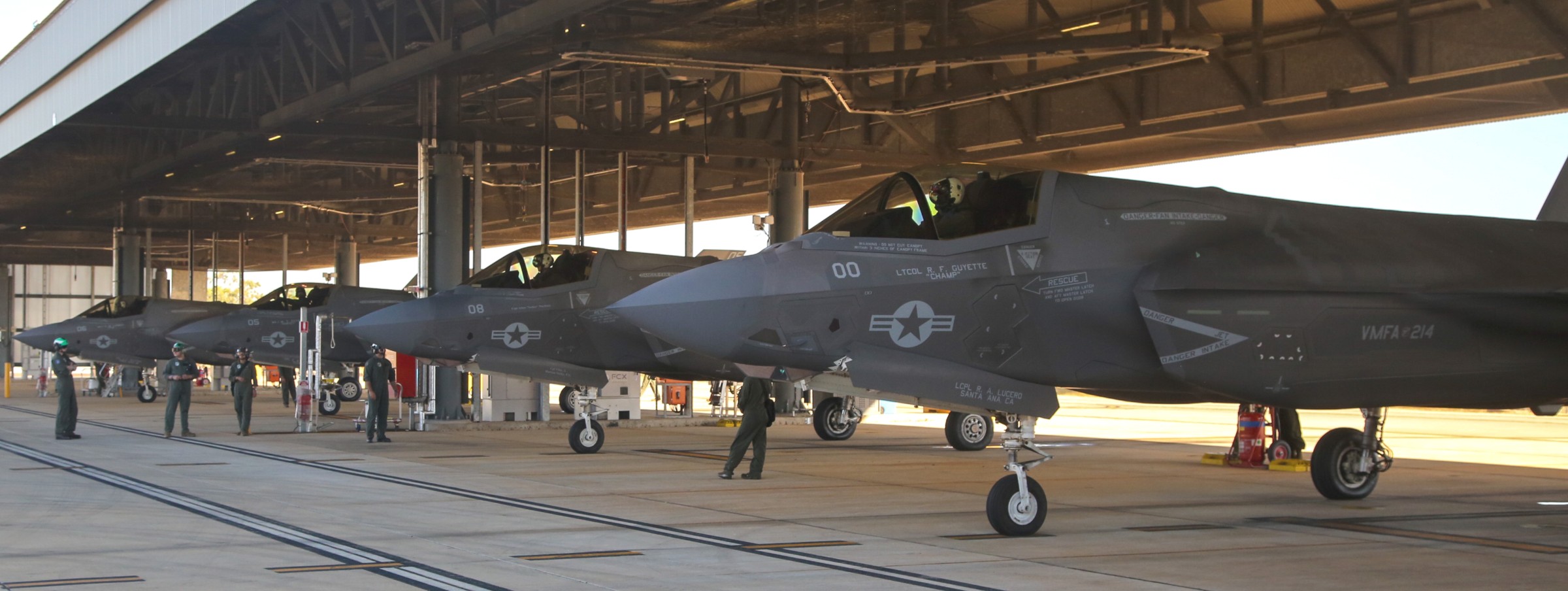 F-35B Lightning II (VMFA-214) at RAAF Tindal, Australia - May 2024 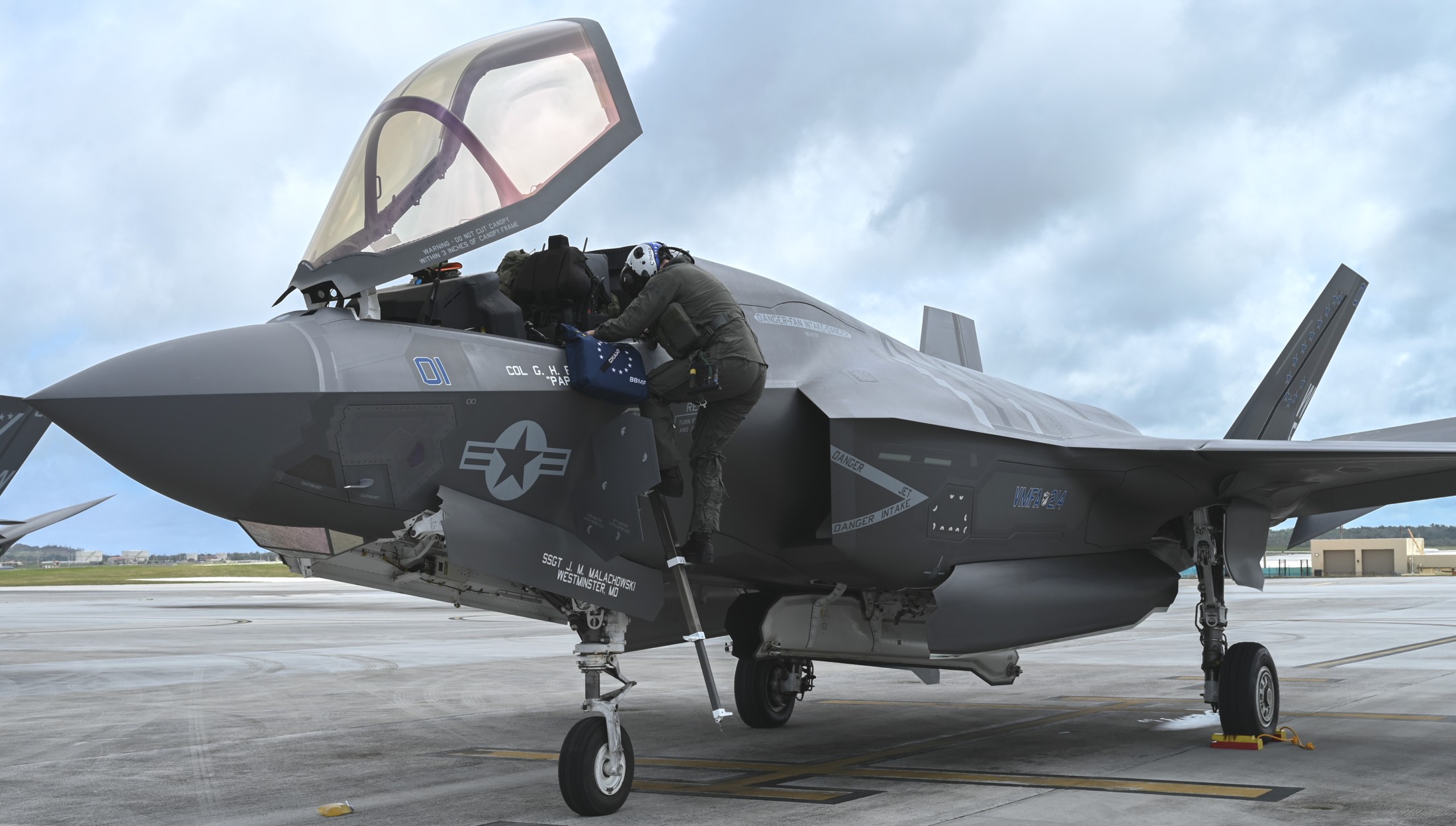 F-35B Lightning II (VMFA-214) at Andersen AFB, Guam - May 2024 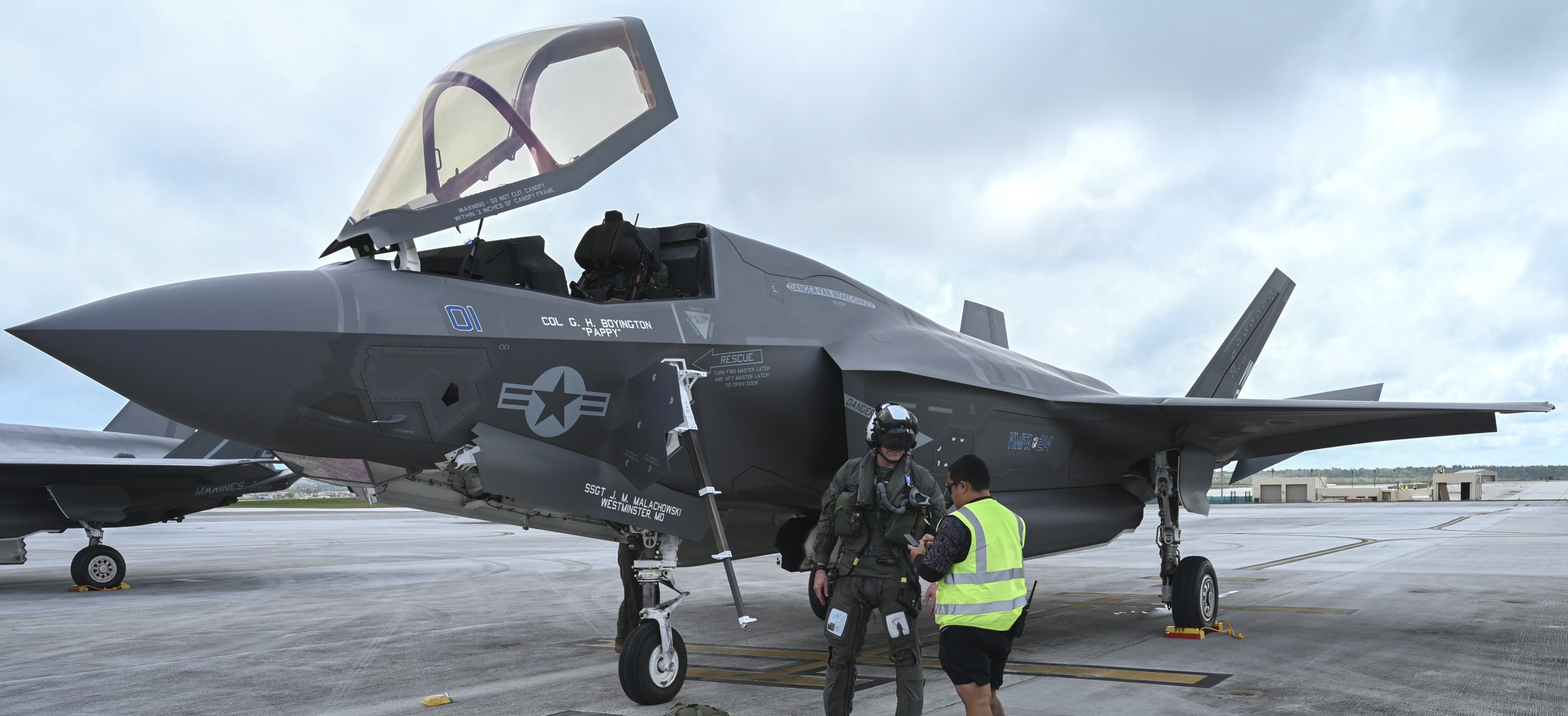 F-35B Lightning II (VMFA-214) at Andersen AFB, Guam - May 2024 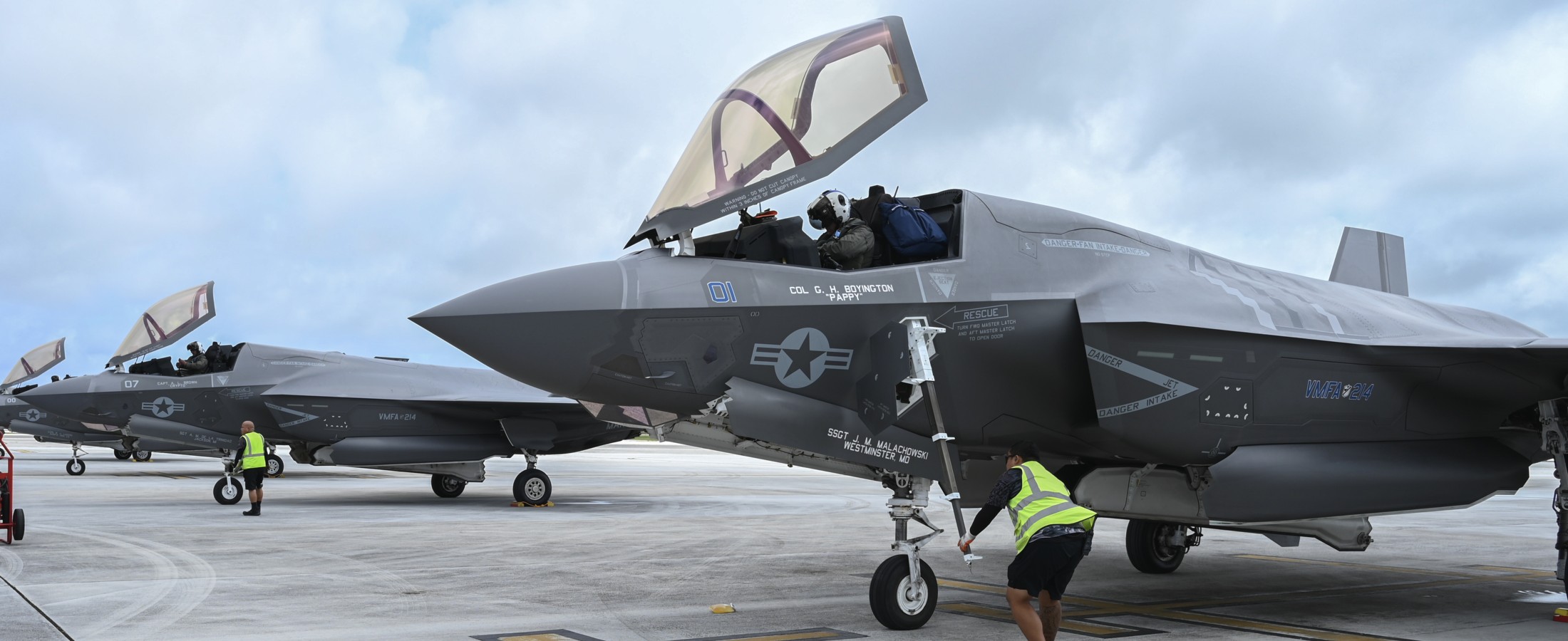 F-35B Lightning II (VMFA-214) at Andersen AFB, Guam - May 2024  F-35B Lightning II (VMFA-214) at Andersen AFB, Guam - May 2024 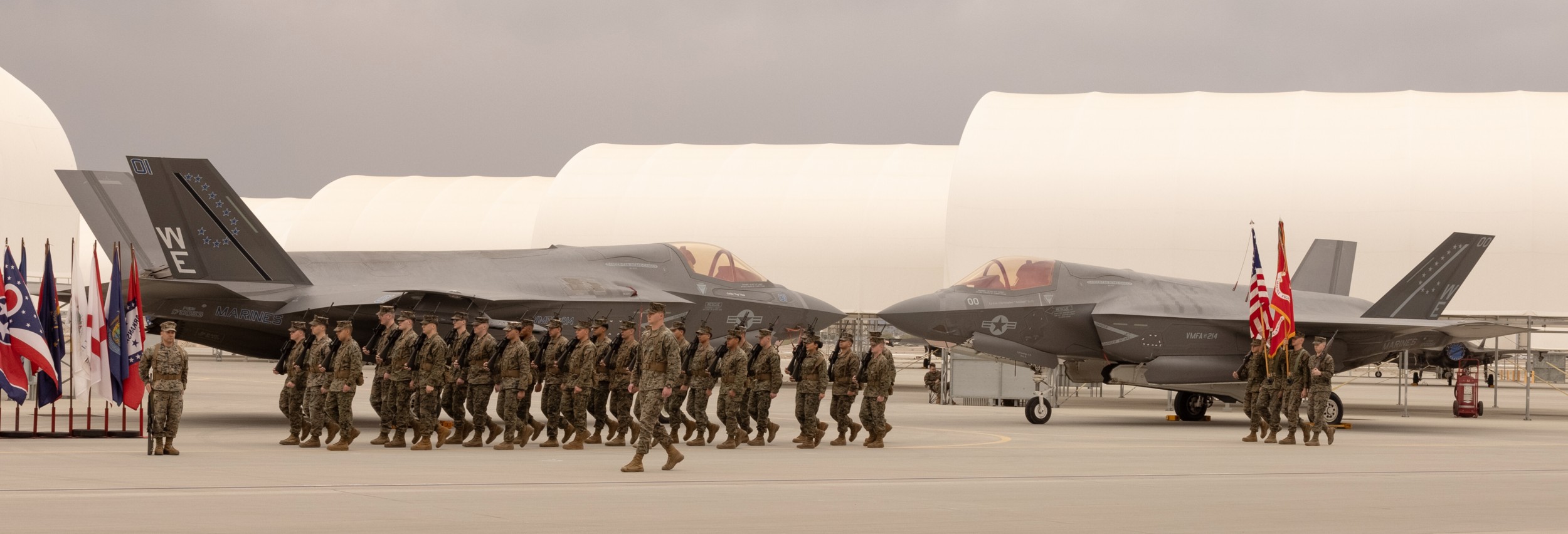 change of command ceremony at MCAS Yuma, Arizona - February 2024 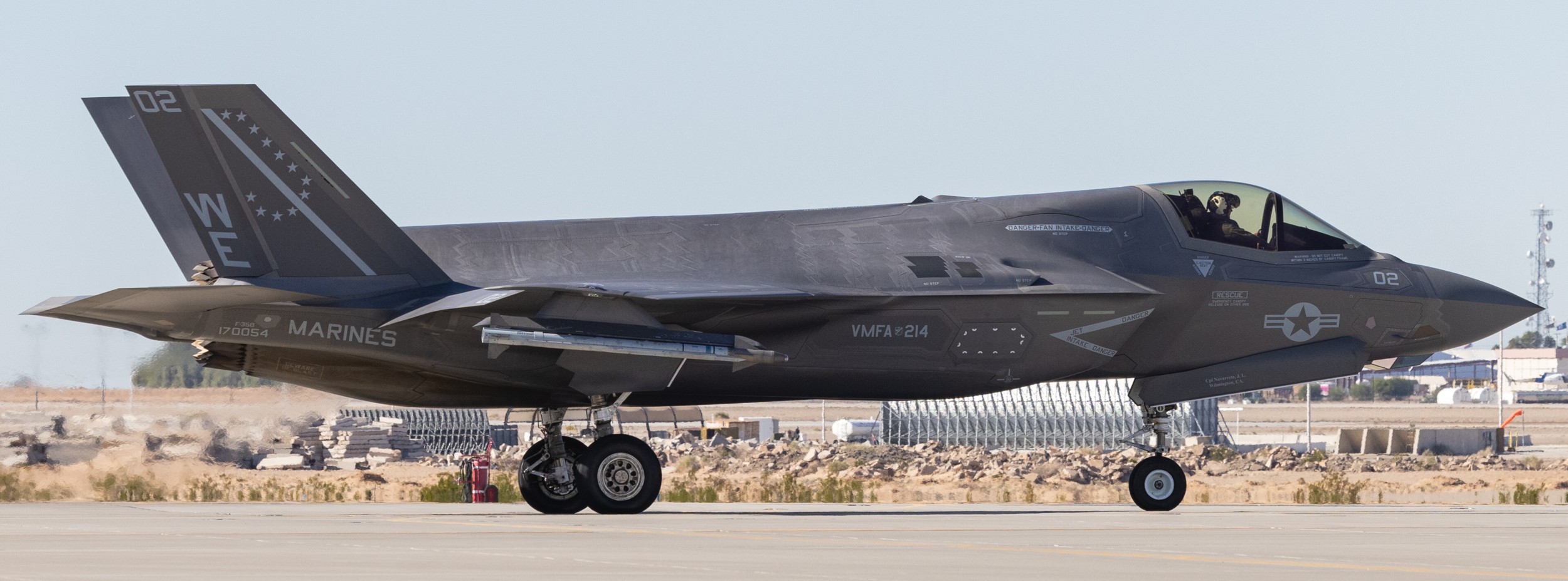 F-35B Lightning II (VMFA-214) during exercise Steel Knight 23.2 at MCAS Yuma, Arizona - December 2023  F-35B Lightning II (VMFA-214) during exercise Steel Knight 23. at Inyokern Airfield, California - December 2023  F-35B Lightning II (VMFA-214) during exercise Red Flag Alaska 23-3 at Eielson AFB, Alaska - August 2023  F-35B Lightning II (VMFA-214) first flight - MCAS Yuma, Arizona - November 7, 2022  F-35B Lightning II (VMFA-214) first flight - MCAS Yuma, Arizona - November 7, 2022 |
||||||
|
Marine Fighter Squadron 214 (VMF-214) was originally commissioned on
1 July 1942, at Ewa Field, on the island of Oahu, in the Hawaiian
Island group. Initially called the “Swashbucklers”, they were
disbanded following their combat tour and the squadron designation
was given to the Marine command on Espiritu Santo. In August 1943, a
group of 27 young men under the leadership of Major Gregory “Pappy”
Boyington (who was later awarded the Congressional Medal of Honor)
were joined together to form the original “Black Sheep” of VMF-214.
Major Boyington had just returned from a year’s tour in China as a
member of the American Volunteer Group, “The Flying Tigers”. In
China, he had downed six enemy planes and became, through actual
experience, one of the originators of American fighter tactics
against the Japanese. The call sign “Black Sheep” was chosen by the squadron to commemorate the unusual way in which the squadron had been formed. The pilots ranged from experienced combat veterans, with several air-to-air victories to their credit, to new replacement pilots from the United States. Major Boyington and Major Stan Bailey were given permission to form the unassigned pilots into a squadron, with the understanding that they would have less than four weeks to have them fully trained and ready for combat. They were very successful. They chose for their badge to carry into battle the black shield of illegitimacy, the bar sinister, a black sheep superimposed, surrounded by a circle of 12 stars, and crowned with the image of their aircraft, the F4U-1 Corsair. What these men accomplished has become Marine Corps history. The Black Sheep Squadron fought their way to everlasting fame in just 84 days. They met the Japanese over their own fields and territories and piled up the smashing record of 203 planes destroyed or damaged, produced eight aces with 97 confirmed air-to-air kills, sunk several troop transports and supply ships, destroyed many installations, in addition to numerous other victories. For their actions, the original Black Sheep were awarded the Presidential Unit Citation for extraordinary heroism in action. The Black Sheep ended their second combat tour on 8 January 1944, five days after Major Boyington was shot down and captured by the Japanese. The original Black Sheep were disbanded and the pilots were placed in the pilot pool in Marine Aircraft Group (MAG)-11. VMF-214 was reformed on 29 January 1944 at Marine Corps Air Station (MCAS) Goleta, near Santa Barbara, California. They deployed aboard the USS Franklin (CV-13) on 4 February 1945. Their mission was to join in operations against Japan and Okinawa. On 19 March, a Japanese bomber hit the USS Franklin. The explosion and resulting fire caused 772 deaths aboard the Franklin including 32 Black Sheep. Many Black Sheep aircraft were launching for a strike on mainland Japan at the time. One, First Lieutenant Ken Linder, was given half credit for shooting down the Japanese bomber that struck the Franklin. This ended VMF-214 involvement in WWII. In April 1945, the Black Sheep were relocated to El Centro, California and then to El Toro, California in October of 1945. In the next few years, the Black Sheep deployed for operations on board the USS Rendova (CVE-114), the USS Baroko (CVE-115), the USS Badoeng Straight (CVE-116), and the USS Boxer (C-21). Flying F4U-4B Corsairs in August 1950, VMF-214 became the first Marine Squadron to see action in Korea. Flying from the USS Badoeng Straight (CVE-116) and the USS Boxer (CV-21), the Black Sheep completed two combat tours in Korea. They participated in key battles to include the Inchon landing and the withdrawal from the Chosin Reservoir. In these and others battles, they provided nearly continual air cover, interdicting supply and communication lines and inflicting heavy damage on numerous ground emplacements and enemy armor. Shortly before the close of hostilities in Korea, VMF-214 returned to MCAS El Toro. Here they exchanged their gallant Corsairs for F9F Panther jets and began another training program. In the spring of 1953, the Black Sheep packed their bags, traded their F9s for the new F2H-4 all-weather Banshee, and headed for the Hawaiian Islands. Upon arrival in the islands, they became part of MAG-13 and the First Marine Brigade. In January 1956, the Black Sheep again received the order to “get ready”. This time, the circumstances were less demanding. In the ensuing 15 months, the Black Sheep covered all aspects of Marine Aviation. On 31 December 1956, the squadron was redesignated Marine All Weather Fighter Squadron 214 (VMF(AW)-214) flying the Banshee. The buildup included instrument flying, bombing, rocketry, strafing, air-to-air gunnery, field carrier landing practice, high and low altitude special weapon drops, and carrier qualifications. VMF(AW)-214 became the first Marine Squadron to be qualified in special weapons delivery in February 1957. The period between Korea and Vietnam saw several significant changes for the Black Sheep. VMF was changed to VMA on 9 July 1957, designating the Squadron as “attack” vice “fighter”. In March 1958, the Black Sheep transitioned to the FJ-4 Fury. Shortly after the transition was completed, VMA-214 and VMF-212 became the first squadrons to deploy by a Trans-Pacific flight. Another aircraft change occurred in January of 1959, when the Black Sheep changed over to the newer FJ-4B. In the FJ-4B Fury, the squadron logged over 27,000 hours as an attack squadron. This included a stretch with over 20,000 accident-free flight hours. On 29 August 1961, The Black Sheep was awarded the CMC safety award for the “most outstanding safety record” achieved among attack squadrons throughout the Marine Corps. On 23 January 1962, the Black Sheep transitioned from the FJ-4B Fury to the A-4B Skyhawk. This began a 27-year association between the Black Sheep and follow-on versions of the Skyhawk. In May of 1965, the Black Sheep were reassigned to MAG-12, 1st Marine Aircraft Wing (MAW), Fleet Marine Force (FMF), Pacific, and relocated to MCAS Iwakuni, Japan. On 21 June 1965, the first Black Sheep division flew into Chu Lai, Republic of Vietnam, and landed on 4,000 feet of Short Airfield for Tactical Support runway. The Black Sheep rotated out of Vietnam in February 1966 to pick up new pilots and personnel. In April 1966, the Black Sheep deployed back to Chu Lai, where combat missions were again flown in support of the Republic of Vietnam. The Black Sheep flew 14,000 hours during 13,000 combat sorties and dropped more than 10,000 tons of ordnance. For their service, VMA-214 was awarded the Navy Unit Commendation with Bronze Star. VMA-214 returned from Vietnam in April 1967, relocated to MCAS El Toro, and was reassigned to MAG-33, 3d MAW, FMF, Pacific. Once in El Toro, the unit became recognized as an operational training squadron for attack pilots, many of whom were replacement pilots bound for Vietnam. During December of 1970, the Black Sheep were reassigned to MAG-13. During the late 1970’s and into the 1980’s, the squadron participated in the Unit Deployment Program (UDP), rotating between MAG-12 and MAG-13. In October 1982, the Black Sheep were awarded the Lawson H. M. Sanderson Award for Attack Squadron of the Year. In September 1987, the Black Sheep squadron once again relocated, this time to MCAS Yuma, Arizona. On 17 October 1987, the Black Sheep again made history by becoming the first squadron to win the prestigious Sanderson Award for a second time. Two significant events occurred in 1989. During the year, the Black Sheep completed 30,000 accident free hours and six years of accident-free flying. Also, in June, the Black Sheep introduced single-seat fixed wing “Night Attack” aircraft to the Marine Corps with the first operational squadron of AV-8B Night Attack Harrier II’s. VMA-214 became the first squadron to introduce the Night Attack capability into the UDP in October 1991 by deploying 20 Night Attack Harriers to MCAS Iwakuni for seven months. Continuing their tradition as pioneers, in July 1993 the Black Sheep conducted a dedicated “Night Systems” deployment to 29 Palms, California. This deployment was designed to chase the moon and fly around the lunar schedule. Ultimately, sorties were conducted throughout the night until shortly before dawn over a period of three weeks. It resulted in the gathering of original medical data on night flying and its effect on pilot performance. From December 1993 to July 1994, Marines of VMA-214 deployed aboard the USS Peleliu (LHA-5) and participated in contingency Operations RESTORE HOPE and QUICK DRAW off the coast of Somalia. Also during this deployment, VMA-214 Detachment B participated in Operation DISTANT RUNNER in Burundi and Rwanda. In October 1994, a detachment from VMA-214 embarked aboard the USS Essex (LHD-2) to support the 13th Marine Expeditionary Unit (MEU). While deployed, the detachment supported Operation SOUTHERN WATCH in Southwest Asia and Operation UNITED SHIELD off the coast of Somalia. During April 1996, VMA-214 again deployed a detachment aboard the USS Tarawa (LHA-1) in support of the 13th MEU. The detachment supported Operation SOUTHERN WATCH off the coast of Kuwait and Operation DESERT STRIKE in Northern Iraq. In 1997, VMA-214 continued to support CONUS deployments while embarking another boat detachment aboard the USS Peleliu (LHA-5). During this time, VMA-214 provided fleet testing of the Automatic Targeting Hand off System (ATHS), a step toward revolutionizing the way the Marine Corps conducts Close Air Support. In August 1997, the Black Sheep were recognized for the third time with the Lawson H. M. Sanderson Award for Attack Squadron of the Year. In 1998 and 1999, the Black Sheep prepared for and deployed aboard the USS Boxer (LHD-4) heading directly to the North Arabian Gulf to take part in Operation DESERT FOX. It was on this deployment that the Harrier Community enjoyed its first operational use of Night Vision Devices for shipboard activities, to include working with helicopters on a shared deck. Meanwhile, the Squadron(-) was busy standing up and training the first West Coast Radar Squadron. As usual, the Black Sheep were leading the charge. The turn of the century presented some of the most challenging yet rewarding years in recent history. Immediately following an extended fleet wide grounding of all Harrier activities, the Black Sheep split the squadron and deployed simultaneously in support of two separate MEU(SOC)s. The squadron(-) deployed to Iwakuni in support of the 31st MEU, while detachment B sailed in support of the 13th MEU(SOC) aboard USS Tarawa (LHA-1). During this deployed period, the Marines of VMA-214 participated in HUMANITARIAN OPERATIONS – EAST TIMOR, INDONESIA. One month later, detachment B was off the coast of Yemen with the 13th MEU(SOC) participating in Operation DETERMINED RESPONSE – recovery of the USS Cole. During this operation, Black Sheep Marines trained in the region and helped provide stability with a constant fixed wing presence. Detachment B also participated in the combined exercise IRON MAGIC from 15-26 November and shore based in Kuwait to conduct Joint training in support of Joint Task Force (JTF) Kuwait. In February 2003, the Black Sheep again answered the Nation’s call to arms. In response to increased tension in the Middle East, the squadron deployed 16 jets and over 250 personnel to Ahmed Al Jaber Air Base, Kuwait. As the only land based Harrier squadron, the Black Sheep were overhead as the Marines of I Marine Expeditionary Force pushed north into Iraq. From the initial strikes of 19 March, the storming of Baghdad, and through the rebuilding of Iraq during the summer of 2003, VMA-214 Harriers were present providing Close Air Support, Aerial Interdiction and Armed Reconnaissance. The Black Sheep flew over 1,900 combat sorties and dropped 236,000 pounds of ordnance in support of Operations SOUTHERN WATCH and IRAQI FREEDOM. Simultaneously, the squadron’s detachment deployed for a full year in support of the 31st MEU. In May 2004, the Black Sheep deployed again to the Middle East in support of Operation IRAQI FREEDOM II. With a week’s notice, the squadron deployed ten Harriers to Al Asad Air Base, Iraq. With the aid of the LITENING II targeting pod, the Black Sheep provided tactical Air Reconnaissance and Close Air Support for multiple Marine and Allied units. VMA-214 simultaneously deployed six Harriers aboard USS Belleau Wood (LHA-3) in support of the 11th MEU. Over a span of nine months, the Black Sheep deployments combined for a total of 1,978 combat sorties in support of operations in An Najaf, Al Fallujah, Baghdad, Ramadi and other small conflicts throughout the Al Anbar province of Western Iraq. In late 2005 the Black Sheep were tasked with deploying two six-plane detachments while the Squadron(-) remained in Yuma and continued to train the remaining pilots for combat. Detachment B deployed to support the 31st MEU in Japan in December. Detachment A deployed aboard USS Peleliu (LHA-5) with the 11th MEU to the North Arabian Gulf in support of Operation IRAQI FREEDOM 4.6 less than two months later. Encompassing the globe, the Marines of VMA-214 had the opportunity to say the sun never set on the Black Sheep. By August 2006, the two detachments had returned to the Squadron(-) at MCAS Yuma after eight months of being tri-sited. The Black Sheep immediately began preparing for a deployment five months later. At the beginning of January 2007, VMA-214(-) returned to its birthplace once again, the Western Pacific, to support the 31st MEU in Japan. Three months into the six month deployment, the squadron learned that the MEU had been extended to a year in order to facilitate the training of units preparing to deploy to Iraq. Shortly before Christmas 2007, the Black Sheep arrived home at MCAS Yuma. In January 2009, the Black Sheep deployed detachment A aboard the USS Boxer (LHD-4) with the 13th MEU. The MEU deployed to the Gulf of Aden, where they conducted anti-piracy operations off the coast of Somalia in direct support of Combined Task Force (CTF) 151 prior to returning to Yuma in August 2009. In May of 2009, the Black Sheep Squadron(-) was reassigned to MAG-40, 2nd MEB and relocated to Kandahar, Afghanistan. The Black Sheep flew 3200 hours during 1375 combat sorties in support of Operation ENDURING FREEDOM II. On 2 July 2009, the Black Sheep provided Close Air Support and Initial Terminal Guidance to the invasion of Marjeh, the largest heliborne insert since Vietnam. VMA-214 returned from Afghanistan right before Thanksgiving in November of 2009 and was reassigned back to MAG-13, 3d MAW. On 22 May 2010, VMA-214 was awarded its fourth Lawson H. M. Sanderson Award for Marine Attack Squadron of the Year. Throughout the remainder of 2010 and into 2011, The Black Sheep were given the rare opportunity of 18 months of training space to train pilots and Marines after their return from Afghanistan. In June of 2011, the Black Sheep deployed six aircraft to Japan in support of the 31st MEU. During the deployment, the Black Sheep supported the 31st MEU’s Certification Exercise (CERTEX) and the Philippines Exercise (Phiblex). Concurrent with this deployment, VMA-214 Detachment A prepared and deployed with the 11th MEU in November 2011 with a return date of June 2012. During 2012, VMA-214 deployed to Tyndall AFB, FL to conduct a live AIM-120A shoot off the coast. With the successful employment of the AIM-120As, the Black Sheep became the first operational US Harrier squadron to fire the Advanced Medium Range Air-to-Air Missile (AMRAAM) in Marine Corps history. In 2013 the squadron supported dual MEUs, with the 31st MEU departing first in June. MA-214 DET ALPHA trained 9 pilots for Carrier Operations and successfully embarked on the USS BOXER two months later in support of the 13th MEU. With 2015 upon the squadron, VMA-214 focused on preparing for upcoming dual deployments. Early September 2015, VMA-214 DET A deployed 6 AV-8Bs, 9 pilots, and 90 Marines in support of the 13th MEU on the USS Boxer. By early November, VMA-214(-) deployed 8 A/C, 14 pilots, and 120 Marines to Japan in support of both Unit Deployment Program (UDP) and the 31st MEU. Both halves of the Squadron served with distinction during this time period, as DET A supported contingency operations throughout the CENTCOM area of responsibility in support of Operation INHERENT RESOLVE. The detachment was able to leave USS BOXER and conduct combat operations from Al Udeid, Qatar for over thirty days, providing over 600 combat flight hours. In July 2017, the Black Sheep deployed the 15th MEU AV-8B detachment with eight Harriers, 10 pilots, and 90 Marines aboard the USS America; a first for USMC Harrier Operations. The Detachment went ashore to execute combat operations in support of Operation INHERENT RESOLVE. During November 2017, the 15th MEU AV-8B Detachment flew a milestone 633.1 hours in support of combat operations. The story of the Black Sheep in 2019 was to train and deploy a fully qualified and lethal AV-8B Detachment for the 11th MEU, while the squadron reconstituted and built up for an early 2020 10 plane combat deployment. In May 2019, 105 Marines, nine pilots, and six aircraft deployed in support of the 11th MEU. The Black Sheep of the 11th MEU again moved ashore in the Central Command area of operations and executed over five weeks of sustained combat operations with zero sorties lost for maintenance. Their professionalism and resiliency in combat operations resulted in over 2,000 lbs. of munitions employed against the enemy. The Marines of VMA-214 hit the ground running in 2020 to prepare for their upcoming tasking as the Immediate Response Force. This began with supporting Service Level Training Exercise (SLTE) 2-20 from MCAS Yuma, which was a resounding success: the squadron completed an unprecedented 100% of the 219 assigned sorties and delivered 113,976 pounds of general, precision, and forward-firing ordnance. As spring arrived, VMA-214 stood ready, and soon answered the call to deploy to Prince Sultan Air Base, Saudi Arabia within a few short weeks. The Black Sheep, amidst the onset of coronavirus, successfully deployed 270 Marines and 350 tons of gear using its 10 AV-8Bs and 7 dedicated cargo aircraft. Combat flights began immediately after quarantine, launching 4 jets per day, 6 days per week. Each flight entailed a 7-9 hour mission, with a 700 mile transit to Iraq. In just 35 days of supporting the ground force commander, VMA-214 flew 670 combat hours over 95 sorties, employing over 5,000 pounds of precision and forward-firing ordnance. The squadron maintained above 80% readiness and dropped only one sortie, a tremendous feat in 120 degree heat with the immense logistical challenges of a novel and austere air base. Upon return, the squadron immediately set about absorbing personnel and equipment from VMA-311, which went into a C-5 status in October. Without pause, the squadron returned to operations, this time preparing for the upcoming 11th MEU. The Marines of VMA-214 began 2021 ready to make history as the West Coast’s final Harrier deployment. In their path stood several unique obstacles: aircraft divestment, with the Black Sheep ultimately fixing and sending off eight fully mission capable aircraft; personnel reduction, with the squadron losing more than half of its Marines; and a full inspection cycle, bookended by five intensive pre-deployment work-up periods at sea. During these work-up months the Black Sheep totaled 1,031 hours without dropping a single MEU sortie; their minimal time spent ashore was almost entirely comprised of inspections. The Black Sheep deployed aboard USS ESSEX in early August and flew 520 sorties and 1,035 flight hours during the 11th MEU, conducting operations throughout the Pacific and Middle East. They completed more than 50 combat sorties and 400 combat flight hours in support of Operation INHERENT RESOLVE, carrying 3,000 pounds of ordnance for thousands of miles daily without missing a single tasking line. These sorties were executed both from USS ESSEX and while detached to Al Udeid Air Base, Qatar. The squadron returned to Yuma on 27 February 2022 and swiftly divested its remaining aircraft and equipment. To this day, the Black Sheep of VMA-214 and VMFA-214 continue their tradition of true and faithful service to the Nation and beloved Corps. The squadron continued to produce and maintain a highly skilled and tactically proficient cadre of pilots and maintainers. A laser focus on safely generating combat readiness is the hallmark of 214’s leadership in Marine tactical aviation. From the time of “Pappy” Boyington to the present day, the Black Sheep have demonstrated a standard of excellence and esprit de corps that has marked them as one of the finest military units of Country and Corps. USMC - - - - - news release: As part of the transition from the AV-8B Harrier to the F-35B Lightning II, VMA-214 was re-designated as Marine Fighter Attack Squadron (VMFA) 214. The F-35B Lightning II is replacing the AV-8B Harrier to introduce unmatched capabilities to the Marine Corps. The F-35B Lightning II represents a leap forward in air dominance by providing the operational agility and tactical supremacy Marines need to provide expeditious and lethal support. “Having previously served in VMA-214 and flown the AV-8B for many years, the ‘Black Sheep’ and the Harrier hold a special place in my heart,” said U.S. Marine Corps Maj. Gen. Bradford J. Gering, the commanding general of 3rd MAW. “As 3rd MAW says a bittersweet farewell to the Harrier, we are excited to increase our number of F-35B squadrons with the re-designation of VMFA-214.” VMA-214 was initially commissioned as Marine Fighter Squadron (VMF) 214 on July 1, 1942, on Oahu, Hawaii, flying the F4F Wildcat before transitioning to the F4U-1 Corsair. The squadron completed two combat tours under the previous call-sign “Swashbucklers” before reforming as the “Black Sheep” under the leadership of U.S. Marine Corps Major Gregory “Pappy” Boyington in August 1943. The Marines of VMF-214 selected the new squadron namesake to highlight the pilots’ varied experience levels. From seasoned veterans with multiple combat tours under their wings to pilots fresh from flight school, the Black Sheep built their legacy from years of arduous fighting in World War II. As a result of their accomplishments, VMF-214 became the first Marine fighter squadron awarded the Presidential Unit Citation for extraordinary heroism in action. On July 9, 1957, the squadron was re-designated VMA-214 as the Black Sheep transitioned to flying fixed-wing attack aircraft. In Vietnam, the Marines of VMA-214 distinguished themselves as an attack squadron, flying the trustworthy A-4 Skyhawk from expeditionary airfields in Chu Lai. The Black Sheep continued to fly the A-4 until 1989, when they transitioned to the AV-8B Harrier. Over the next 30 years, the Black Sheep participated in combat operations throughout the globe, including Operation Restore Hope, Operation Iraqi Freedom and Operation Enduring Freedom. Most recently, VMA-214 completed its final AV-8B deployment with the 11th Marine Expeditionary Unit, during which they participated in Operation Inherent Resolve. “The re-designation of VMA-214 to VMFA-214 is the end of a legacy for the Black Sheep and Marine Aircraft Group-13,” said U.S. Marine Corps Lt. Col. Keith Bucklew, the outgoing commander of VMA-214. “This symbolic event finalizes the sundown for Harriers on the West Coast and closes the chapter on 58 years of attack aircraft operations for the Black Sheep. “Finishing this mission with a successful 11th Marine Expeditionary Unit deployment is a testament to the viability and performance of the Harrier over the last 33 years and, more importantly, the talent of the Marines who managed them,” Bucklew said. “The AV-8B will be missed in the skies of Yuma, but it is time to transition to the next generation of fighter attack aircraft.” “The F-35’s fifth-generation strike fighter capability brings more lethality and flexibility to combatant commanders than any other fighter platform,” said U.S. Marine Corps Lt. Col. Christopher Kelly, the commanding officer of VMFA-214. “The STOVL capability inherent in the F-35B variant allows the Marine Corps to operate expeditiously and from remote locations, making the model uniquely qualified at supporting expeditionary advanced base operations.” 3rd MAW continues to “Fix, Fly and Fight” as the Marine Corps’ largest aircraft wing and remains combat-ready, deployable on short notice, and lethal when called into action. Written by 1st Lt. Zachary Bodner and Lance Cpl. Courtney Robertson, 3rd Marine Aircraft Wing Public Affairs. source: USN |
||||||
| patches + more | ||||||
| | seaforces.org | US Marine Corps Air units start page | |
